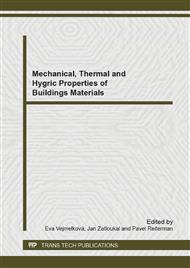p.114
p.119
p.125
p.130
p.136
p.141
p.145
p.149
p.154
Properties of Cement Composites Containing Coir Pith
Abstract:
Application of agricultural waste materials as building materials not just provides solutions of environmental problems related to the waste management, but it also decreases the use of limited available natural resources and energy. The research in this work is focused on using coconut waste, in the form of natural and chemically treated coir pith, as admixture partially replacing cement in cement composites. The coir pith is the residue acquired during the extraction coir fiber from the outer protective husk of the coconut. Basic physical properties, mechanical, thermal and hygric parameters of several mixtures were studied. The results of measurements showed the influence of amount of coconut addition primarily on parameters such as the bulk density, open porosity, mechanical strengths, moisture transport parameters and thermal parameters. Restrictions for utilization of this waste material relate primarily with its low adhesion ability to the cement matrix.
Info:
Periodical:
Pages:
136-140
Citation:
Online since:
July 2014
Price:
Сopyright:
© 2014 Trans Tech Publications Ltd. All Rights Reserved
Share:
Citation:


